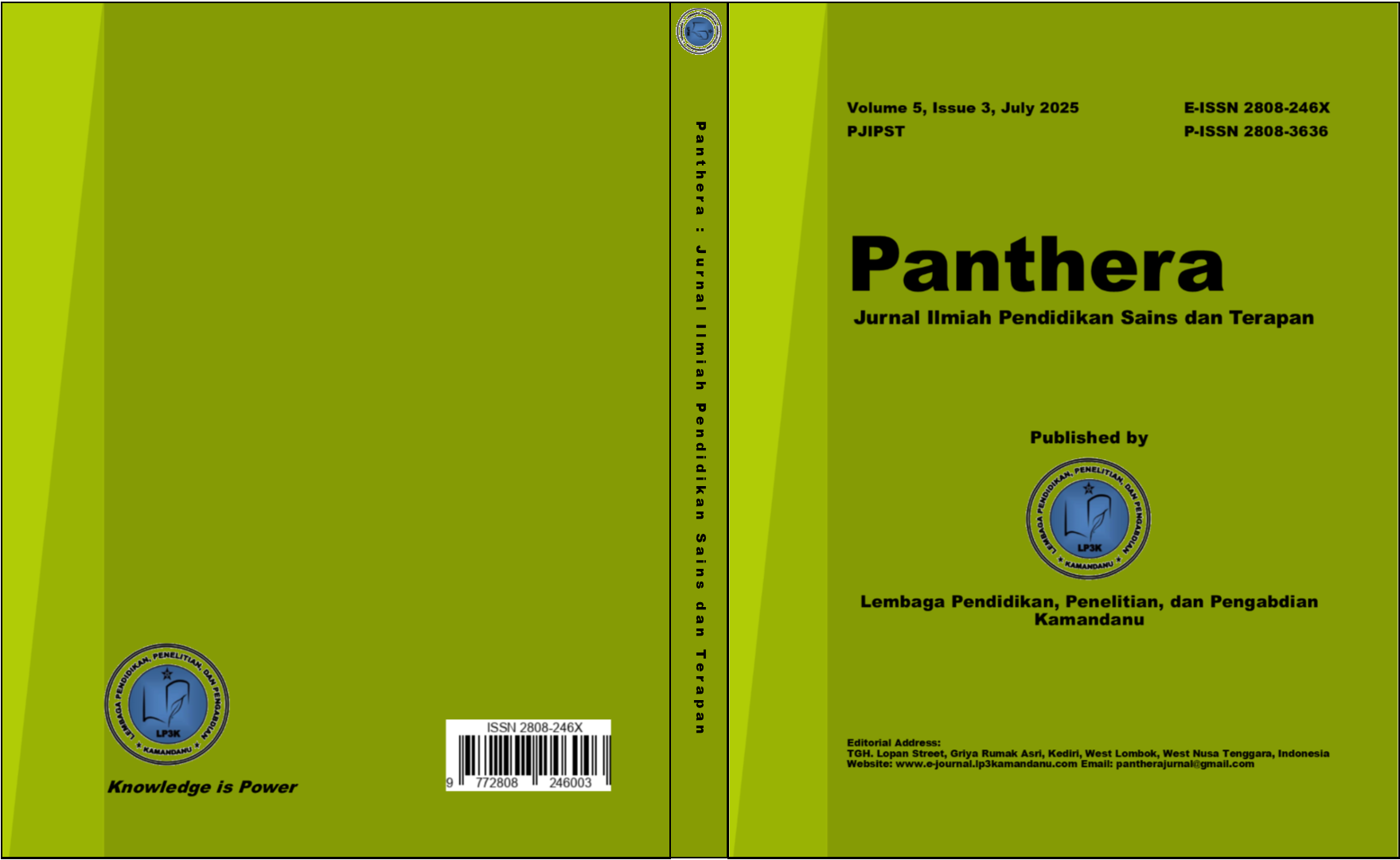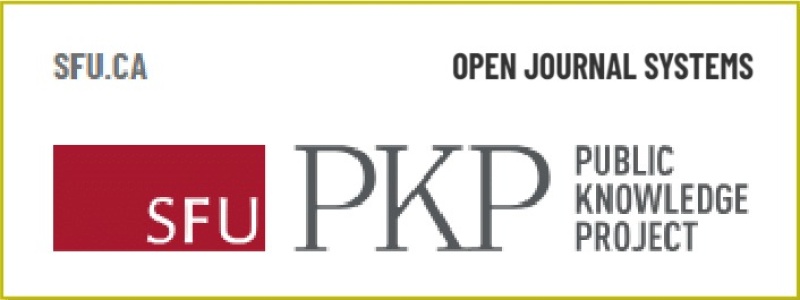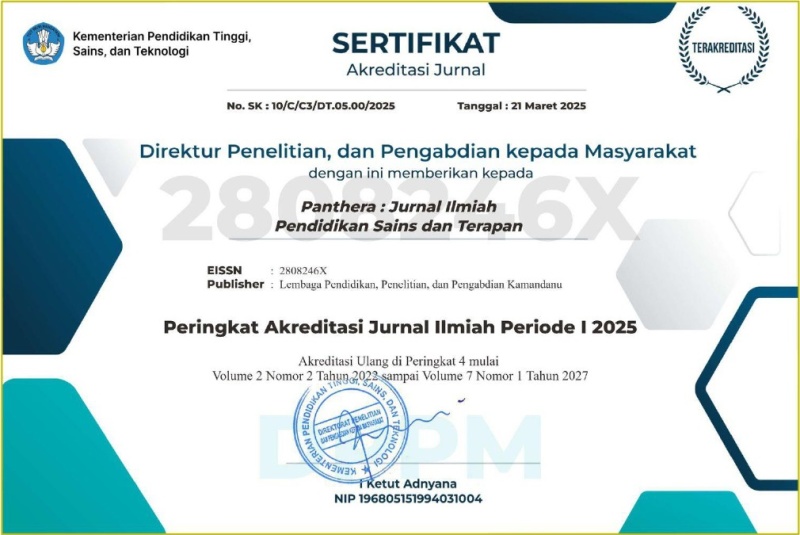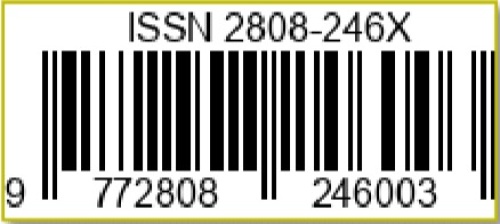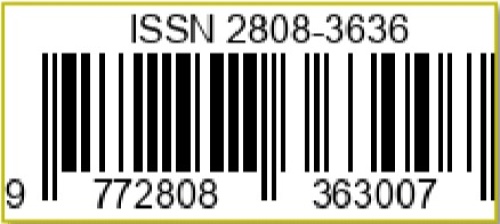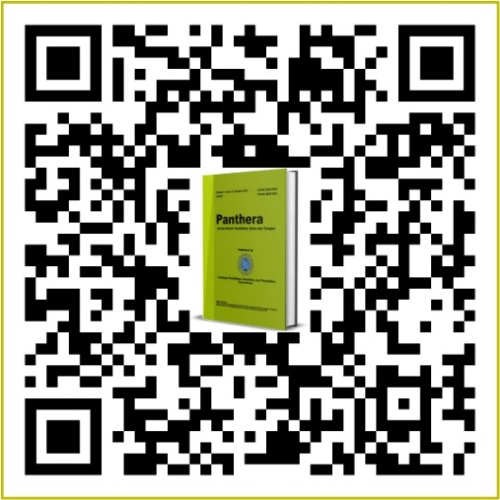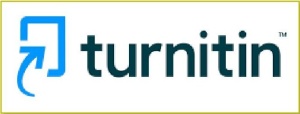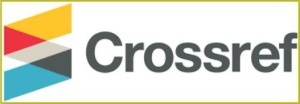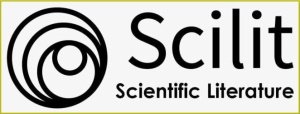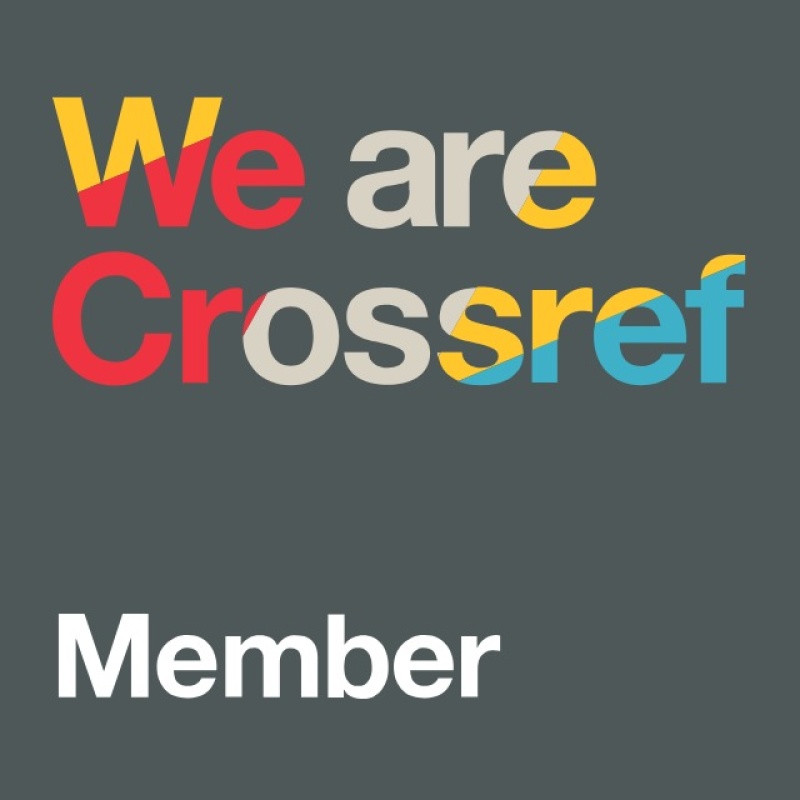Pengaruh Model Pembelajaran Kooperatif Tipe Two Stay Two Stray (TSTS) terhadap Efikasi Diri dan Hasil Belajar Siswa pada Materi Asam Basa Kelas XI SMA
DOI:
https://doi.org/10.36312/panthera.v5i3.510Keywords:
Self-Efficacy, Learning Outcomes, Learning ModelsAbstract
The purpose of this study was to determine the significant effect of the Two Stay Two Stray (TSTS) cooperative learning model on students' self-efficacy and learning outcomes, and to determine the correlation between self-efficacy and learning outcomes at SMA Swasta Cerdas Murni. The research sample was taken using a cluster sampling technique, namely class XI IPA 3 as the experimental class and XI IPA 1 as the control class. The instruments used were objective tests to measure learning outcomes and non-test questionnaires to measure self-efficacy. Data analysis was carried out through normality, homogeneity, linearity tests, and hypothesis tests using independent sample t-tests and correlation tests. The results showed that the average self-efficacy and student learning outcomes increased significantly after learning. The N-Gain value of self-efficacy in the experimental group was 0.5486 while the learning outcomes were 0.8212, both of which were higher than the control group. For learning outcomes, the N-Gain value of the experimental class (0.8212) was also higher than the control class (0.7515). The t-test results showed a significant difference between the experimental and control groups in terms of self-efficacy and student learning outcomes (p < 0.05). Furthermore, there was a significant correlation between self-efficacy and learning outcomes (p = 0.001). Thus, TSTS-based learning has been proven effective in improving student self-efficacy and learning outcomes, and there is a strong positive relationship between the two variables.
Downloads
References
Ananda, Y. Y. T., & Novita, D. (2018). Penerapan Model Pembelajaran Kooperatif Tipe Two Stay Two Stray pada Materi Laju Reaksi untuk Melatihkan Self Efficacy Siswa Kelas XI MIPA 2 SMA 1 Blitar. Unesa Journal of Chemical Education, 7(2), 200-207. https://doi.org/10.26740/ujced.v7n2.p%25p
Asni, A., Wildan, W., & Hadisaputra, S. (2020). Pengaruh Model Pembelajaran Inkuiri Terbimbing terhadap Hasil Belajar Kimia Siswa Materi Pokok Hidrokarbon. Chemistry Education Practice, 3(1), 17-29. https://doi.org/10.29303/cep.v3i1.1450
Dalimunthe, M., Syuhada, F. A., Azwar, W., & Sihombing, J. L. (2020). Pengaruh LKS dalam Model Pembelajaran CTL terhadap Hasil Belajar dan Kemandirian Belajar Siswa pada Materi Larutan Elektrolit dan Non Elektrolit. Jurnal Guru Kita PGSD, 4(4), 16-24. https://doi.org/10.24114/jgk.v4i4.19922
Djonomiarjo, T. (2019). Pengaruh Model Problem Based Learning terhadap Hasil Belajar. Aksara : Jurnal Ilmu Pendidikan Nonformal, 5(1), 39-46. https://doi.org/10.37905/aksara.5.1.39-46.2019
Efendi, I., & Safnowandi, S. (2016). Peningkatan Keterampilan Sosial dan Hasil Belajar Kognitif Siswa melalui Metode Belajar Aktif Tipe GGE (Group to Group Exchange). Jupe: Jurnal Pendidikan Mandala, 1(1), 42-49. http://dx.doi.org/10.58258/jupe.v1i1.54
Fadilah, K., Ulfa, M., & Utami, B. (2022). Hubungan antara Self-Efficacy dan Kemandirian Belajar terhadap Hasil Belajar Kimia Materi Senyawa Hidrokarbon dan Minyak Bumi Siswa Kelas XI SMA Al Islam 1 Surakarta Tahun Ajaran 2020/2021. Jurnal Pendidikan Kimia, 11(1), 103-108. https://doi.org/10.20961/jpkim.v11i1.50680
Fitri, A., Rahim, R., Nurhayati, N., Azia, A., Pagiling, S. L., Natsir, N., Irmawaty, I., Munfarikhatin, A., Simanjuntak, D. N., Hutagaol, K., & Anugrah, N. E. (2023). Dasar-dasar Statistika untuk Penelitian. Medan: Yayasan Kita Menulis.
Fitri, A. A., & Pertiwi, F. N. (2023). Efektivitas Model Pembelajaran Two Stay Two Stray (TSTS) Berbasis Teacher and Peer Feedback terhadap Kemampuan Refleksi Peserta Didik. Jurnal Tadris IPA Indonesia, 3(3), 238-251. https://doi.org/10.21154/jtii.v3i3.2166
Handayani, R., Sain, U., & Nurhadi, M. (2021). Pengaruh Media Google Form dalam Model Pembelajaran Berbasis Masalah terhadap Hasil Belajar Siswa Materi Asam Basa. Orbital : Jurnal Pendidikan Kimia, 5(1), 81-90. https://doi.org/10.19109/ojpk.v5i1.6227
Krismayana, P., Widiastuti, A. E. S., & Ashadi, A. (2020). Implementasi Model Two Stay and Two Stray (TSTS) pada Pembelajaran Kimia Materi Larutan Penyangga Berbantuan Peta Konsep untuk Meningkatkan Kemampuan Kerja Sama dan Hasil Belajar Siswa Kelas XI MIPA 1 SMA Al Islam 1 Surakarta. Jurnal Pendidikan Kimia, 9(1), 61-70. https://doi.org/10.20961/jpkim.v9i1.33870
Muti’ah, M., Siahaan, J., & Sukib, S. (2021). Upaya Meningkatkan Motivasi dan Pemahaman Ilmu Kimia melalui Demonstrasi Kimia Bagi Siswa SMA N 1 Labuapi. Jurnal Pengabdian Magister Pendidikan IPA, 4(2), 1-5. https://doi.org/10.29303/jpmpi.v4i2.704
Ningsih, W. F., & Hayati, I. R. (2020). Dampak Efikasi Diri terhadap Proses & Hasil Belajar Matematika. Journal on Teacher Education, 1(2), 26-32. https://doi.org/10.31004/jote.v1i2.514
Norfai, S. (2020). Manajemen Data Menggunakan SPSS. Banjarmasin: Universitas Islam Kalimantan Muhammad Arsyad Al-Banjary.
Nuryadi, N., Astuti, T. D., Utami, E. S., & Budiantara, M. (2017). Buku Ajar Dasar-dasar Statistik Penelitian. Bantul: Sibuku Media.
Pertiwi, A. D., Nurfatimah, S. A., & Hasna, S. (2022). Menerapkan Metode Pembelajaran Berorientasi Student Centered Menuju Masa Transisi Kurikulum Merdeka. Jurnal Pendidikan Tambusai, 6(2), 8839-8848. https://doi.org/10.61787/taceee75
Rahmayanti, Y., Kusasi, M., & Syahmani, S. (2020). Studi Korelasi Efikasi Diri dengan Hasil Belajar Materi Kelarutan dan Hasil Kali Kelarutan. Vidya Karya, 34(2), 92-100. https://doi.org/10.20527/jvk.v34i2.7114
Sa’adah, N., & Yasthophi, A. (2019). Pengaruh Penerapan Model Two Stay Two Stray terhadap Keterampilan Berkomunikasi dan Hasil Belajar Siswa pada Materi Struktur Atom. Konfigurasi : Jurnal Pendidikan Kimia dan Terapan, 5(1), 15-22. https://doi.org/10.24014/konfigurasi.v5i1.12418
Saragi, L., & Dalimunthe, M. (2022). Pengaruh Model Pembelajaran Problem Based Learning dengan Menggunakan PowerPoint terhadap Hasil dan Minat Belajar Siswa pada Materi Laju Reaksi di Kelas XI SMA. Educenter : Jurnal Ilmiah Pendidikan, 1(4), 353-361. https://doi.org/10.55904/educenter.v1i4.108
Sukarelawa, M. I., Indratno, T. K., & Ayu, S. M. (2024). N-Gain vs Stacking. Bantul: Suryacahaya.
Sulistyanti, L., Siahaan, J., & Junaidi, E. (2019). Pengaruh Model Pembelajaran Two Stay Two Stray (TSTS) Dipadukan dengan Metode Demonstrasi terhadap Hasil Belajar Kimia. Chemistry Education Practice, 2(1), 17-24. https://doi.org/10.29303/cep.v2i1.1137
Yandi, A., Putri, A. N. K., & Putri, Y. S. K. (2023). Faktor-faktor yang Mempengaruhi Hasil Belajar Peserta Didik (Literature Review). Jurnal Pendidikan Siber Nusantara, 1(1), 13-24. https://doi.org/10.38035/jpsn.v1i1.14
Downloads
Published
How to Cite
Issue
Section
License
Copyright (c) 2025 Anisya Humaida Hasibuan & Makharany Dalimunthe

This work is licensed under a Creative Commons Attribution-ShareAlike 4.0 International License.
-
Attribution — You must give appropriate credit, provide a link to the license, and indicate if changes were made. You may do so in any reasonable manner, but not in any way that suggests the licensor endorses you or your use.
-
ShareAlike — If you remix, transform, or build upon the material, you must distribute your contributions under the same license as the original.

